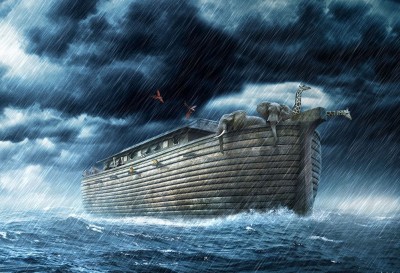The covenant with Noah binds together God’s purposes in creation with His purposes in redemption.
—O. Palmer Robertson, The Christ of the Covenants (1980)
Dominion and the Fall
 Man’s fall into sin corrupted his own nature. His natural impulse toward dominion didn’t disappear, but it became twisted and distorted into tyranny and irresponsibility. In his first sin, man thought and acted as if he himself were God, but when the consequences of his sin appeared, he denied any culpability. He blamed his society and his environment. In short…he blamed God.
Man’s fall into sin corrupted his own nature. His natural impulse toward dominion didn’t disappear, but it became twisted and distorted into tyranny and irresponsibility. In his first sin, man thought and acted as if he himself were God, but when the consequences of his sin appeared, he denied any culpability. He blamed his society and his environment. In short…he blamed God.
God responded to man’s fall with judgment aimed at salvation. God cursed the Serpent and predicted his destruction. He placed curses upon the ground, upon childbearing, and upon man’s own body. And yet God didn’t rescind His original command. Instead, God promised grace through the Seed of the woman and sent Adam and Eve, still man and wife, out into a hostile wilderness to worship by sacrifice and till the ground in the face of thorns and thistles and—ultimately—death.
The complex of curses that would make man’s dominion more difficult also served to restrain man’s sin. Shortened life spans, difficult pregnancies, and a hostile nature would all serve to keep man focused on his work. Man would earn his bread by “the sweat of his brow.”
In this way, God replaced the covenant of creation with a covenant of grace and promise wrapped up in the language of judgment and curse. But at no point did God turn aside from His original program for man and the Earth.
The Waters of Noah
In the centuries after the Fall, the human family apostatized and filled the Earth with corruption and violence. “But Noah found grace in the eyes of the LORD” (6:8). And then, in the context of the Flood and the Ark, the word covenant first appears in Scripture: “But with thee will I establish my covenant” (Gen. 6:18).
God’s dealings with Noah were in terms of His redemptive grace in Christ. It was by justifying faith that Noah “prepared an ark to the saving of his house; by which he condemned the world, and became heir of the righteousness which is by faith” (Heb. 11:7). Because of this, Peter talks about the Flood as a baptism (1 Pet. 3:220-21). By its waters God separated Noah and his family from the old polluted world and ushered them into a new heaven and earth.
And while the ark floated above the submerged Earth, it held all the living covenant community in the presence of God. God called Noah and his family into the ark and later sent them out of the ark (7:1; 8:16). He was with them the whole time. So in this sense the ark was the Church of Jesus Christ while the earth remained buried in water. And it was to this covenant community that God entrusted (again) the care and stewardship of the planet. God’s covenant with Noah was a covenant with the Church; the later apostasy of the human family doesn’t alter this.
When the Flood was over and Noah and his family came out from the ark, Noah immediately sacrificed to the Lord. It was in response to this blood sacrifice that God gave His first promise to preserve the Earth from cataclysm until the end of redemptive history. The blood sacrifice, of course, points to Jesus Christ. His atoning blood is the foundation of all of God’s promises; it is the fountain of “common grace” as well as special grace.
God’s Response to Sacrifice: Blessing
As Noah stood before the altar, God spoke: “And God blessed Noah and his sons, and said unto them, Be fruitful, and multiply, and replenish the earth” (Gen. 9:1). This is the language of sovereign grace. The wording reminds us of the original mandate in Genesis 1. But now the command, “Be fruitful, and multiply,” points most directly toward one Seed, the promised Messiah.
But it also points further and more broadly. It points beyond the cross to all the promised seed, to all those whom Jesus will save. But until the wheat is mature and ready for harvest, God lets the weeds grow in the field for the sake of the wheat. When Jesus said this, He wasn’t talking about some common grace arrangement: He was talking about the kingdom of God in the biggest and most explicit terms (Matt. 13:24-30, 36-43).
It is in this light that we should understand God’s promise to preserve the world from another Flood and His authorization of capital punishment. Both are Messianic in focus. Their goal is the preservation of human society for the sake of Messiah and His people.
We shouldn’t be concerned, then, that God’s covenant with Noah doesn’t make any explicit mention of the coming Seed. There was no need. Noah was obviously the ancestor of the coming Messiah. And everything else in the covenant is preparation for the coming of the kingdom of God.
Covenantal Continuity
God established His covenant with Noah before the Flood. He expanded on its details once the Flood was over. But it is most certainly the same covenant, begun in grace and faith, sealed with the baptismal waters of the Flood, and issuing in covenant man’s renewed dominion in a new world.
It is also important that we observe the continuity between this covenant, the covenant of promise that God made with Adam and Eve at the Garden gate, and the original Dominion Covenant. Under all three, man was supposed to marry, labor, and worship. The absence at certain points of recorded commandments to this effect in no way annulled any of these three ordinances. The covenantal assumption is that of continuity.
The Dominion Mandate Revisited
And so as we look at the details of the restated Mandate, we shouldn’t be surprised that God didn’t repeat all the original details or that He added new provisions. The Fall had altered the way that man had to exercise godly dominion. So God told Noah that the beasts would be afraid of man; that man could kill the beasts for food; and that men would need to execute murderers in order to maintain the civil order necessary for man’s work of dominion.
And, God promised to continue His orderly providence until the final end. He said that while Earth remains, “seedtime and harvest”—the regular botanical processes tied to the astrophysical seasons—“and cold and heat”—God’s ordering of heat flow (thermodynamics)—“and summer and winter”—Earth’s tilt on its axis and its revolution about the Sun—“and day and night”—Earth’s rotation on its axis—“shall not cease” (Gen. 8:22). This providential ordering of creation—an order that God would only interrupt on rare occasions by divine miracle—is essential to man’s task of dominion. Agriculture, botany, astronomy, physics, chemistry, and the whole host of sciences depend upon this providential regularity. Given the miraculous nature of the Flood, man might well question whether dominion would even be possible in this new world. God chose to assure man that it would.
So, we have continuity, but with some variation to deal with new redemptive-historical circumstances. The covenant is new, but not wholly new. It is aimed at the restoration of dominion, but only through grace and in Christ.
Conclusion
The Noahic covenant, like all of the covenants of promise, is centered on Jesus. All grace is for Christ’s sake, whether it be the saving grace that brings forth regeneration and faith or the general mercy of God that preserves creation until Christ has gathered all His Church and finished the work the Father has given Him.
The Noahic covenant had as its goal the kingdom and reign of Jesus Christ. It preserved the world for His coming; it preserves the world while He is gathering and sanctifying His Church; and it will come to its glorious end in the revelation of Jesus Christ from heaven. It is, in all its dimensions, a Christ-centered covenant.
For Further Reading
O. Palmer Robertson, The Christ of the Covenants (Phillipsburg, NJ: Presbyterian and Reformed Publishing Co., 1980).
Gary North, Dominion and Common Grace, The Biblical Basis for Progress (Tyler, TX: The Institute for Christian Economics, 1987).
Gary North, The Dominion Covenant: Genesis (Tyler, TX: Institute for Christian Economics, 1982).
David Bruce Hegeman, Plowing in Hope, Toward a Biblical Theology of Culture (Moscow, ID: Canon Press, 1999).
Francis Nigel Lee, The Central Significance of Culture (N. p.: The Presbyterian and Reformed Publishing Co., 1976).
 Off The Grid News Better Ideas For Off The Grid Living
Off The Grid News Better Ideas For Off The Grid Living




